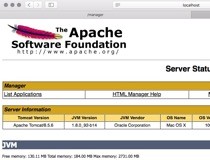To check the version of Apache installed run the following command in the Terminal. $ httpd -v macOS Mojave comes with Apache/2.4.34. To start Apache web server run the following command. $ sudo apachectl start This command will start Apache server. When you use sudo in the terminal then you will be prompted to enter your admin password to proceed. Download Apache Tomcat for Mac - Open source and Java based web server designed to provide its users with a pure and simple to use Java platform for running web apps.
The Servlet 4.0 specification is out and Tomcat 9.0.x does support it. Time to dive into Tomcat 9.
Prerequisite: Java
Since OS X 10.7 Java is not (pre-)installed anymore, let’s fix that by installing a Prebuilt OpenJDK Binary. Easy to follow details about how to install OpenJDK are available here. Anyway, after opening the Terminal app,
hopefully shows something like this:

Whatever you do, when opening Terminal and running ‘java –version’, you should see something like this, with a version of at least 1.8.x I.e. Tomcat 9.x requires Java 8 or later.
JAVA_HOME is an important environment variable, not just for Tomcat, and it’s important to get it right. Here is a trick that allows me to keep the environment variable current, even after a Java Update was installed. In ~/.zshrc, I set the variable like so:

Installing Tomcat
Here are the easy to follow steps to get it up and running on your Mac
- Download a binary distribution of the core module: apache-tomcat-9.0.40 from here. I picked the tar.gz in Binary Distributions / Core section.
- Opening/unarchiving the archive will create a new folder structure in your Downloads folder: (btw, this free Unarchiver app is perfect for all kinds of compressed files and superior to the built-in Archive Utility.app)
~/Downloads/apache-tomcat-9.0.40 - Open to Terminal app to move the unarchived distribution to /usr/local
sudo mkdir -p /usr/localsudo mv ~/Downloads/apache-tomcat-9.0.40 /usr/local - To make it easy to replace this release with future releases, we are going to create a symbolic link that we are going to use when referring to Tomcat (after removing the old link, you might have from installing a previous version):
sudo rm -f /Library/Tomcatsudo ln -s /usr/local/apache-tomcat-9.0.40 /Library/Tomcat - Change ownership of the /Library/Tomcat folder hierarchy:
sudo chown -R <your_username> /Library/Tomcat - Make all scripts executable:
sudo chmod +x /Library/Tomcat/bin/*.sh
Tomcat 9.x
Starting and stoping Tomcat works with executing the provided scripts, like so:/Library/Tomcat/bin/startup.sh
/Library/Tomcat/bin/shutdown.sh
Finally, after your started Tomcat, open your Mac’s Web browser and take a look at the default page: http://localhost:8080
Tomcat is a Servlet container (Web server that interacts with Servlets) developed under the Jakarta Project of Apache Software Foundation.
In this post we will see How to Install Apache Tomcat on Mac OS X.
Step 1 – Download and unzip the tar.gz.
Download a zip of the core module: apache-tomcat-9.0.0.M22.zip from the official website of Apache Tomcat. (Binary Distributions / Core section):
How To Download Apache Tomcat For Mac Pc
Open/unzip the zip will create a folder structure in your Downloads folder.
Step 2 – install:
